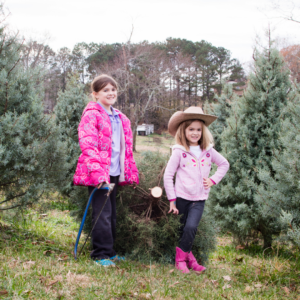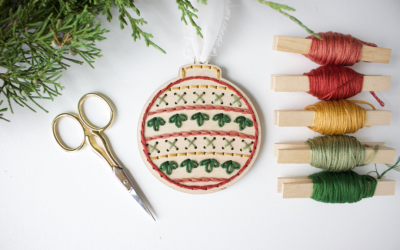Given the emotion surrounding the debate between real and fake Christmas trees, Diane Muno wants you to embrace some new terminology.
Muno, after all, straddles that debate as well as anyone: She has fond memories of growing up with real trees and sells fake ones. She is also the owner of two Estes Park Christmas stores, Christmas Shoppe and Spruce House.
Muno doesn’t like the terms “fake” and “real.” Those are judgey words. She prefers to call them fresh trees and artificial trees, and she will correct you until you use her words. “I will train you,” she says and laughs.
Given that, let’s take a look at the advantages and disadvantages of both.
Real, er, fresh trees
Two years ago, Aaron Jeffrey reluctantly walked into the City of Fort Collins offices to get a sales permit for the AJ’s Christmas Trees lot he’s operated for 17 years. He was talking to a clerk there about the hardships of running the business, which he plants on the lot of La-Z-Boy Furniture Galleries.
Every year, he works reselling fresh trees 13 hours a day, after a long season of growing, buying and going to farmers markets to sell. The holidays were yet another busy season after his busy seasons, and his wife, Amparo Jeffrey, hated it. Why can’t they enjoy Christmas and reward themselves for a year of hard work? Aaron admitted to himself that his wife’s argument was a compelling one.
The clerk sensed his reluctance and stopped him. You’re a holiday tradition for families, she told him, just like Charlie Brown and opening a gift on Christmas Eve. Her comment revitalized him.
“It’s like a ritual,” says Aaron, who nearly everyone knows as AJ. “They load up the car and come and get themselves a tree.”
Those who own fresh tree lots sell emotion as much as they’re selling trees. They’re selling CHRISTMAS. They’re selling the smell in the house, and the cold winter night you trudge out to get it, and the cocoa and pie and TV specials you watch when you’re done.
Couples get engaged at the Creekside Tree Nursery in Boulder. They sell experiences. They even have an option where you can cut a tree down yourself with a bow saw.
“Most people in this area are tired of fake,” says Shannon Von Eschen, the owner of Creekside. “They are tired of chemicals and the fact that it’s not a renewable resource. Fresh-cut trees smell good. They are providing oxygen when growing and joy when they are cut down.”
More customers want the cutting experience, even with the U.S. Forest Service offering the chance for years (see page 38), instead of buying a tree from Creekside’s nursery, Von Eschen says. Von Eschen says the business began offering the service years ago.
“On a whim, we just threw trees in the ground for fun,” she says. “Now we are planting hundreds, and it’s a big job, but people love it. They get exactly what they want, and if it snows it’s better.”
AJ says his business attracts other business, which is why La-Z-Boy loves having him on a lot, and Centerra asked him about having a lot at their shopping center this season. Look for it later this month.
Many believe artificial trees are more sustainable, and that could be true if they keep them for more than a dozen years, AJ says, but most consumers don’t keep them that long. Studies are inconclusive as to what’s more sustainable, but AJ’s argument is this:
The plastic trees wind up in the landfill. Fresh trees, he said, help the climate while they grow, and once they die, cities grind them up for free into mulch and give it away.
“The footprint is actually much larger for a fake tree,” he says.
Fake, er, artificial trees
Muno has many fond memories of fresh trees but buying them is a difficult process even if you don’t cut them down, and more than a few of her customers can’t do it any longer.
“As time went on, artificial trees became more popular,” says Muno, who also sells a huge collection of ornaments and other decorations. “They unfold now, they’re so much easier to work with, and they look real. People don’t like it when you get a poor tree.”
Artificial trees may also come with lights already installed, and machines that distribute the fresh smell are cheap and easy to run. Muno has three artificial trees in her home. Most of her customers have artificial trees, she says. That trend plays out nationwide: Fewer than one in five still keep real trees in their homes, according to treetopia.com.
One reason for that is, as Muno hinted, artificial trees look much more real than the pink aluminum ones Lucy insisted Charlie Brown buy when they went shopping for a tree. Mac Harman, the founder of Balsam Hill, started the upscale company because he had real trees growing up but had to get an artificial one when a family member became allergic. He hated the way the artificial trees looked at the time.
“It looked like shredded paper on sticks,” Harman said in a phone interview. “When people switch from real trees, they still want it to look like a real tree.” He still takes photos of fresh trees while skiing to give his designers a goal.
ing to give his designers a goal. There are a few Lucys in the world who still want the kitsch, and Harman respects those choices, but that’s not what his company does.
“I even refused to make white trees for many years,” he says, “but I finally relented when we had so many customers ask for them. And, you know, you do get trees that are covered in snow.”
Harman respects family tradition, but he also believes some families get a real tree because tradition compels them to do so. “Ultimately, when they can’t do it anymore, the teens don’t even notice it wasn’t real,” he said. “Then the parents say, ‘Why the heck didn’t we do this sooner?’”
TREE SHORTAGE WOES
Regardless of whether you want a fresh tree or an artificial tree, you may want to get one even before Thanksgiving. Balsam Hill and Northern Colorado tree lot operators say there’s a shortage this year.
Artificial tree supplies are lower than normal because of a manufacturing shortage that’s plagued many industries, from the more recent problem of difficulty in finding workers and months of shutting down because of COVID-19.
Actually, fresh tree supplies have been short for at least a decade. The economy crash from the housing bubble started it, says Shannon Von Eschen, the owner of Creekside Tree Nursery in Boulder.
“People weren’t spending money on trees anymore, so farmers were burning fields and trying to do something else to pay the bills,” she says.
Trees now face issues from climate change, from extreme heat to disease to fires, all of which cut their supply as well as their quality.
“It’s also harder to get certain kinds and bigger trees,” Von Eschen says. “Every supplier can only guarantee what you’ve had before. They won’t even let you switch varieties.”
Many don’t want to grow trees anymore now, especially the kids of tree farm owners, says AJ of AJ’s Christmas Trees in Fort Collins. “They’re making so much money off their land for housing, and the kids are like, ‘Great, sell it, I don’t want anything to do with it’.”
CUT YOUR OWN TREE
A year ago, the U.S. Forest Service had to end Christmas. At least that’s how it felt for people who had cut down their own tree in the Red Feather Lakes area for years.
The Cameron Peak fire, the largest wildfire in state history, not only burned a portion of the area, but it also closed roads leading to it and messed up other surrounding areas.
“We just couldn’t manage that last year,” says Reghan Cloudman, spokeswoman for the Arapahoe and Roosevelt National Forests and the Pawnee National Grassland.
At press time, the district hoped to have a tree-cutting program, but it was unsure what they’d be able to offer, and it won’t be in the same area, although it could be near it. Lots of people were waiting for an answer: The district typically sold more than 3,000 permits on that side before the Cameron Peak blaze.
“The hope is we will have another program,” Cloudman says, “but it will look different.”
The Grand County side of the district hoped to open a more structured experience for a couple weekends, Cloudman says, but that program will look different as well.
The Medicine Bow National Forest in Wyoming offers an alternative that’s relatively close, and permit sales are up. Aaron Foos, spokesman for that district, says officials didn’t know if that was because of Red Feather Lakes closing their cutting or because permits were available online for the first time. COVID-19 also encouraged people to get out, which affected every recreation site in the state.
“Going to get a Christmas tree wasn’t just about the product,” Foos says, “It was a recreational activity.”
The district averaged 4,500 permit sales for the last decade, but last year, according to Foos, they sold more than 6,000.
That forest also had fires affect their cutting areas, but they’re still open. Last year was a bad year in that district as well, but just like northern Colorado, this year wasn’t as bad. The new demand probably won’t affect the forest too much, but if it jumps again this year, it could start to worry rangers a bit.
“If people are only going to one area and taking every Christmas-sized tree, and all the small trees are suddenly gone, yes, that could be a concern,” Foos says. “But right now, no, we haven’t identified that it’s causing any negative impact. It’s beneficial to the forest to thin the forest. That helps the remaining ones. We think that’s still a benefit.”
Go to recreation.gov/tree-permits to purchase a permit in your chosen area. They are available now. The site will also have specific information for your district on where you can go and at what time.







